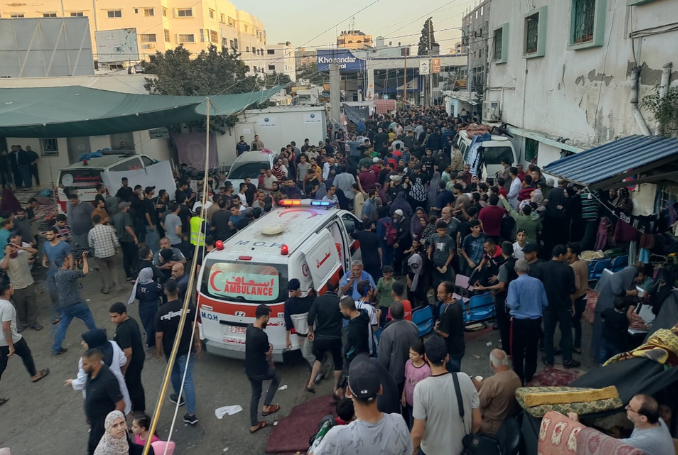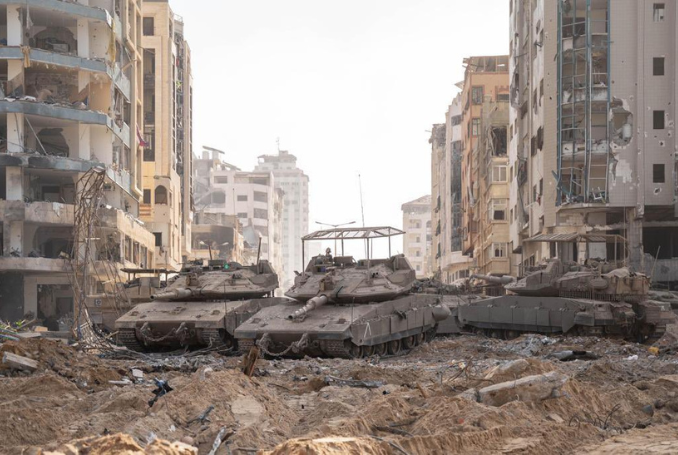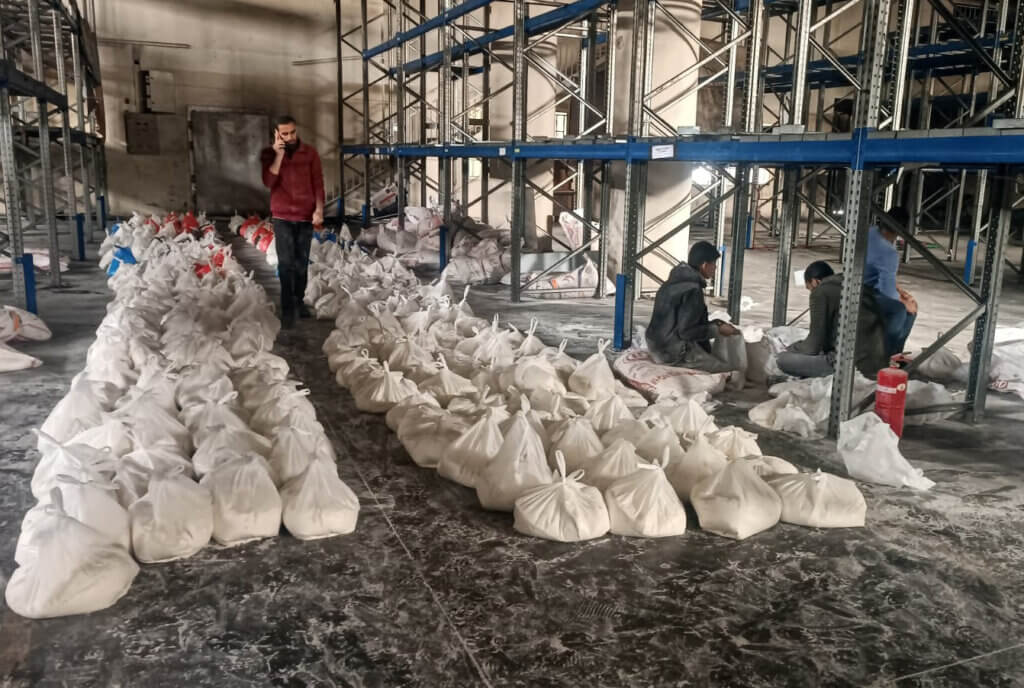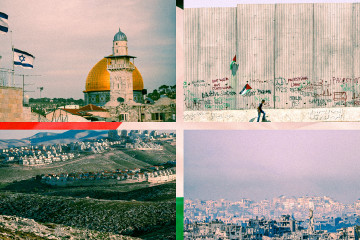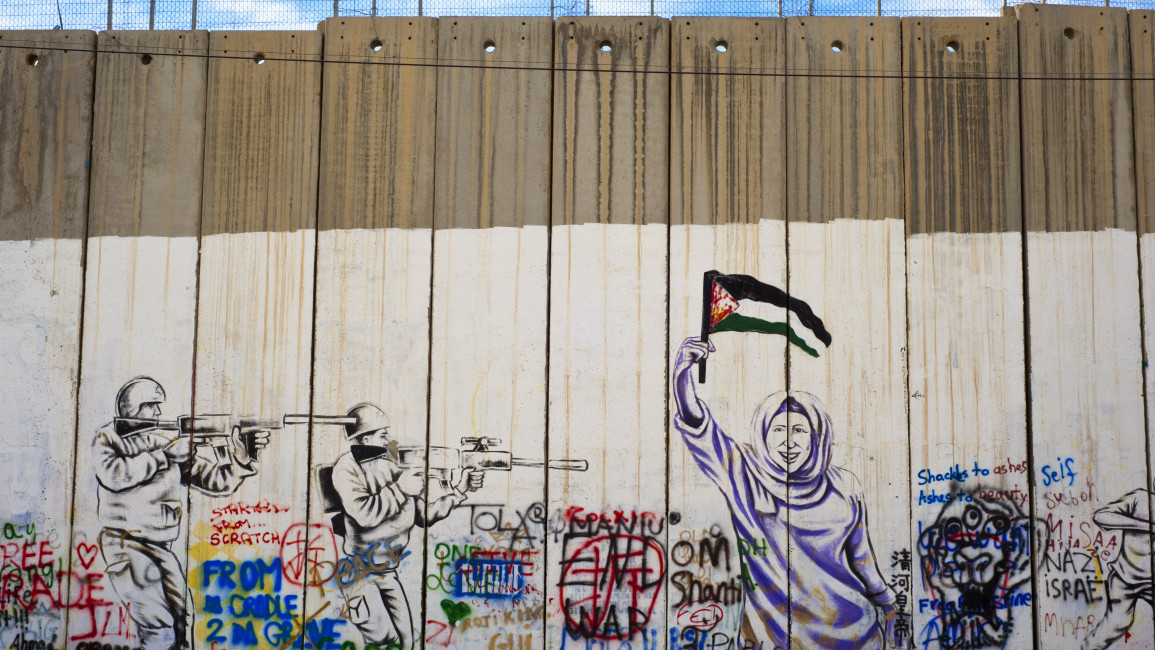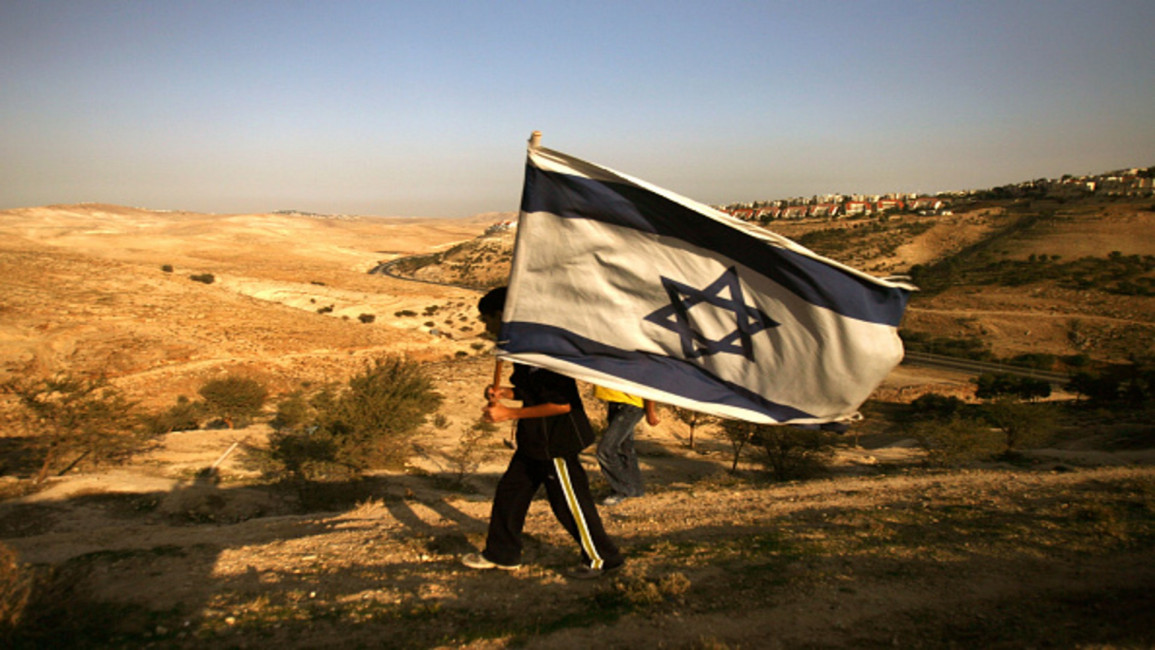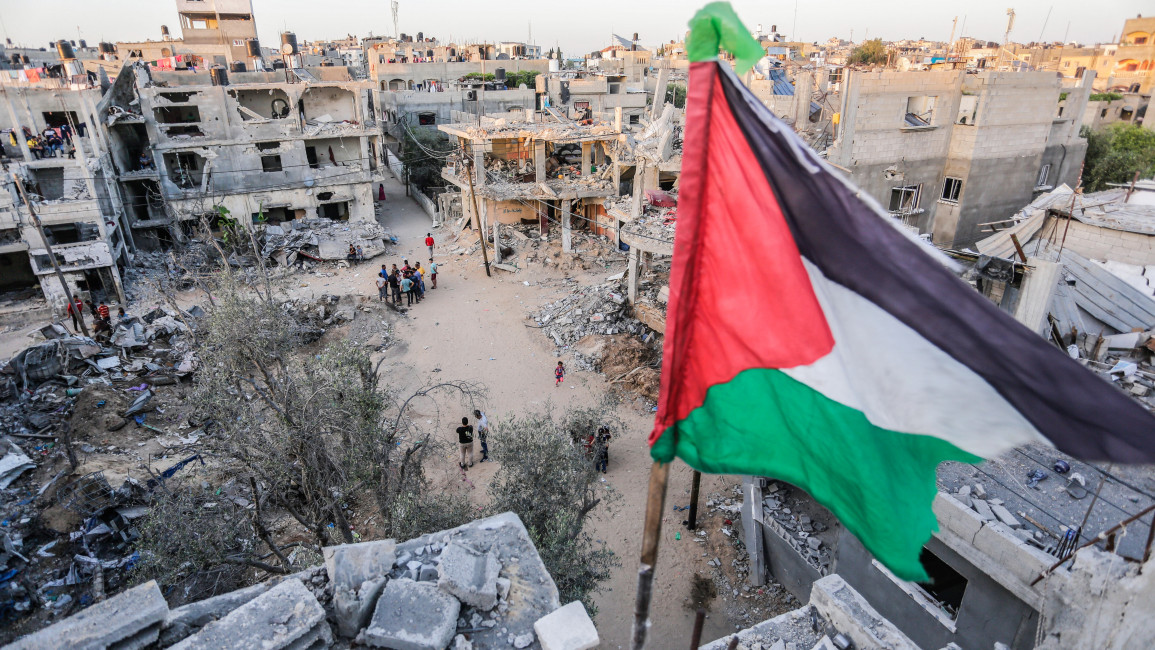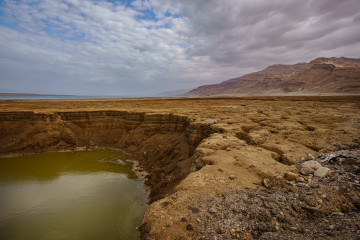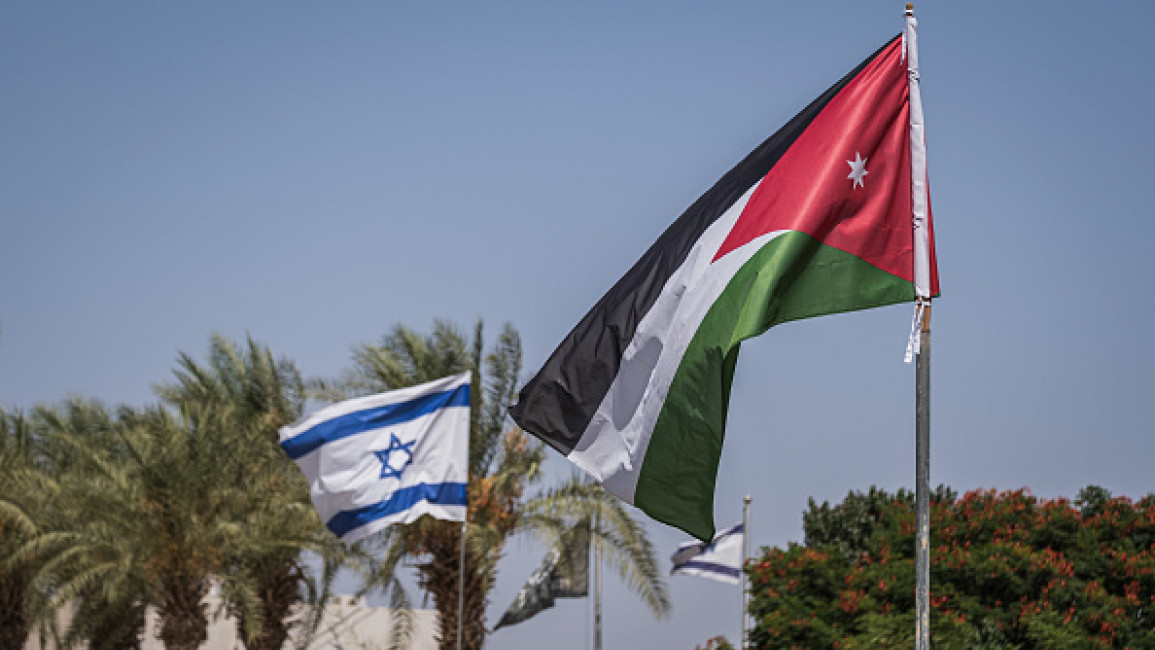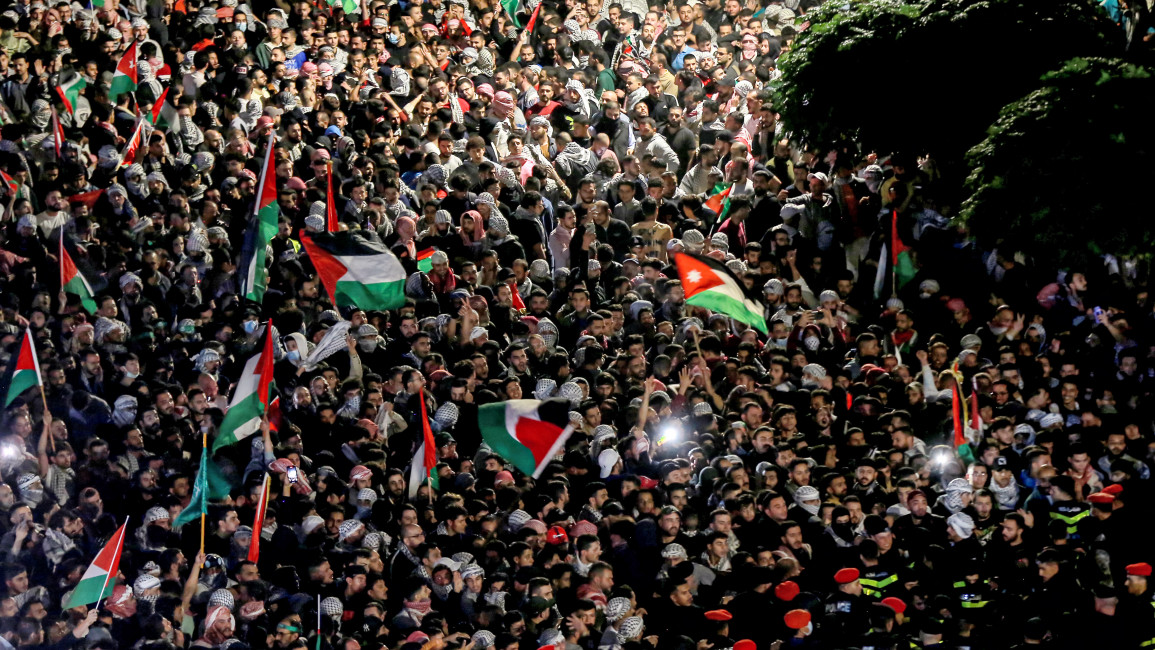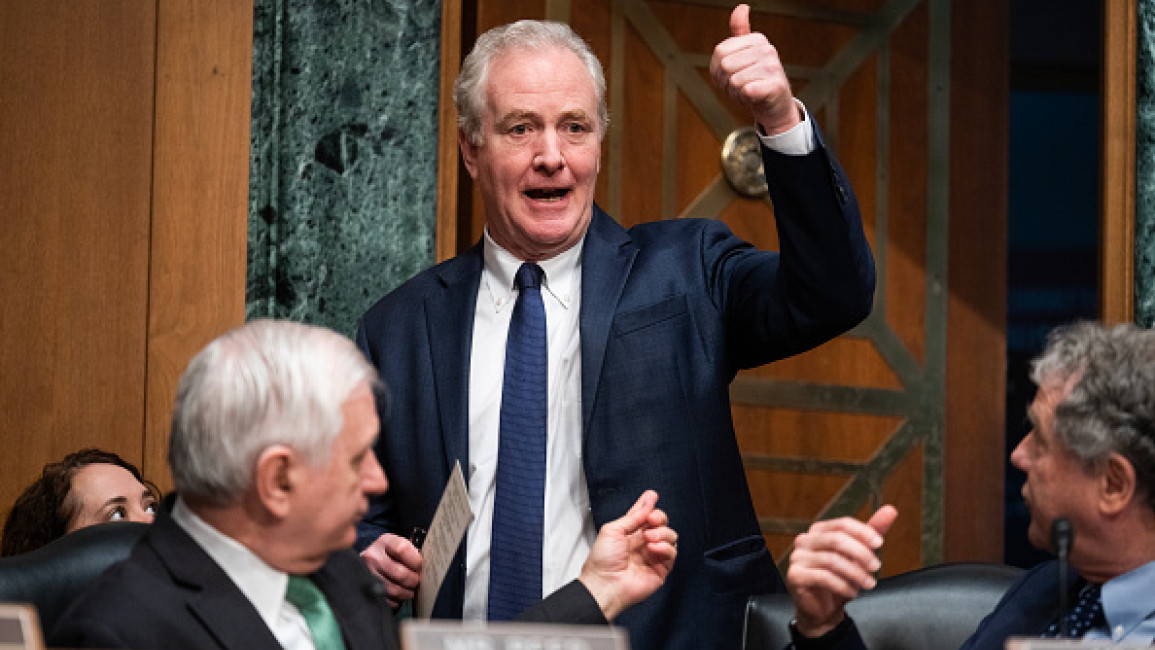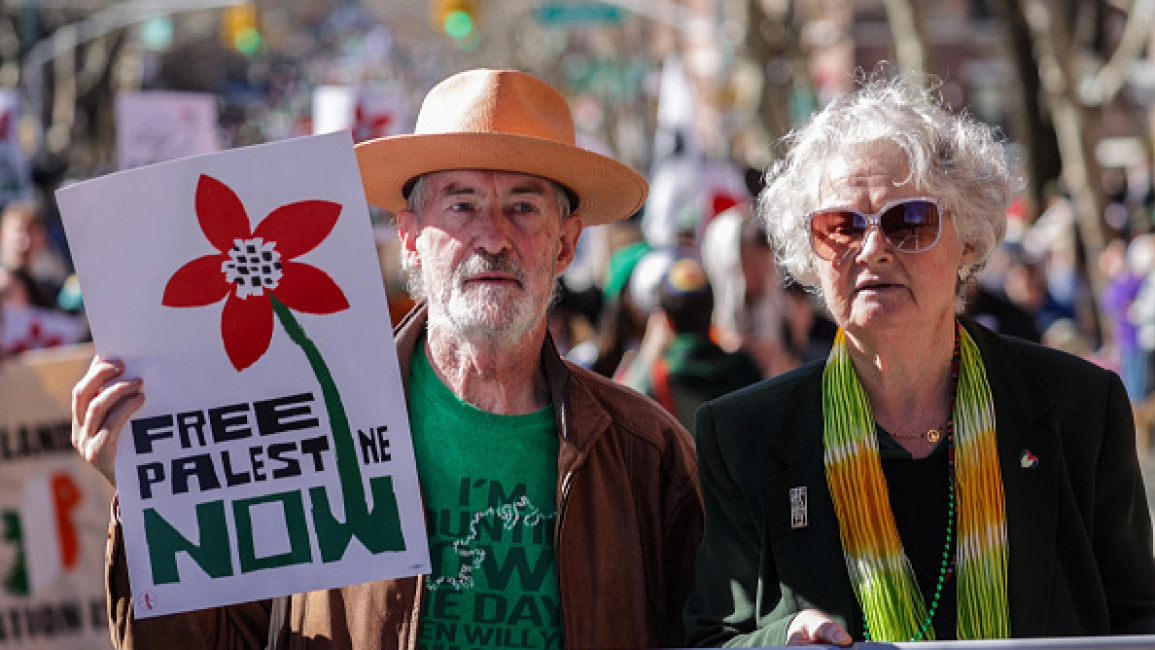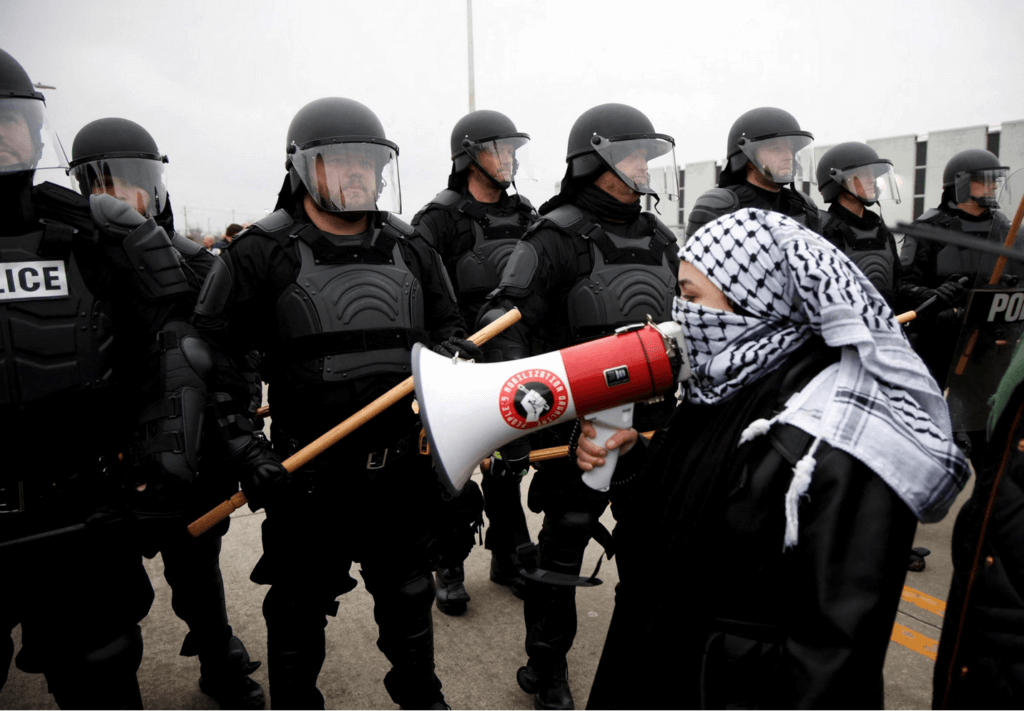‘Bloody Massacre’ – 50 Palestinians Executed, 180 Detained by Israel at Al-Shifa Hospital
Israeli Raid
On Monday morning, Israeli occupation forces stormed the largest hospital in the Strip, took control of the complex and detained scores of people.
Al-Jazeera correspondent Anas al-Sharif reported that Israeli occupation forces detained displaced men and youth after storming a number of schools in the vicinity of the Al-Shifa Complex.
Israeli troops reportedly ordered all women to head to Deir Al-Balah via Al-Rashid Street.
Israeli occupation forces also besieged two schools in the vicinity of the medical complex.
Footage circulating online shows the presence of Israeli military vehicles and bulldozers inside the Shifa Medical Complex with bulldozing operations inside the square.
The siege is now continuing for the second day in a row, and Palestinian civilians are trapped inside the building, with no access to food or water.
Gaza authorities called for “an immediate and urgent intervention by all United Nations and international organizations,” the statement said, adding, “we call on all countries of the free world to stop the genocide war and halt the aggression on the Gaza Strip, which specifically targets civilians, children, and women.”
Gaza Genocide
Currently on trial before the International Court of Justice for genocide against Palestinians, Israel has been waging a devastating war on Gaza since October 7.
According to Gaza’s Ministry of Health, 31,819 Palestinians have been killed, and 73,934 wounded in Israel’s ongoing genocide in Gaza starting on October 7.
Moreover, at least 7,000 people are unaccounted for, presumed dead under the rubble of their homes throughout the Strip.
Palestinian and international organizations say that the majority of those killed and wounded are women and children.
The Israeli aggression has also resulted in the forceful displacement of nearly two million people from all over the Gaza Strip, with the vast majority of the displaced forced into the densely crowded southern city of Rafah near the border with Egypt – in what has become Palestine’s largest mass exodus since the 1948 Nakba.
Israel says that 1,200 soldiers and civilians were killed during the Al-Aqsa Flood Operation on October 7. Israeli media published reports suggesting that many Israelis were killed on that day by ‘friendly fire.’
(The Palestine Chronicle)
‘Please Help Us’ – Palestine Chronicle Speaks to Two Palestinians Inside Besieged Al-Shifa Hospital
Just before Suhoor
“Just before our suhoor meal (just before dawn – PC), we were surprised by the incursion of Israeli special forces into the Al-Shifa Medical Complex in Gaza City, amid heavy gunfire,” H.S., one of the Palestinians who were besieged inside the hospital, told The Palestine Chronicle.
“The quadcopter drones surrounded the compound, firing at anyone attempting to leave,” he added.
H.S., who preferred not to disclose his full name for fear of reprisal from the occupation forces, continued: “We were taken aback by the fact that Israel decided to storm Al-Shifa for the second time.”
The medical compound is currently hosting thousands of displaced Palestinians, including children, women, elderly, in addition to hundreds of patients.
“None of us could leave the place, so we all sought refuge inside the building. The place was extremely crowded, we heard children’s cries echoing, relentlessly. Fear was paralyzing, and the sounds of shelling and gunfire continued for hours.”
As the news spread regarding the storming of Al-Shifa, people in Gaza started worrying about the fate of their relatives, trapped inside the hospital.
“Our families called repeatedly to check on us, but we were in an extremely difficult situation,” H.S. explained.
“The chances of being killed, injured or arrested were very high”.
“They (the Israeli army – PC) demolished the tents of Palestinian journalists and they detained a large number of them. All those arrested were stripped of their clothes, handcuffed, blindfolded, and placed in a room inside the complex for several hours,” the eyewitness said.
“My house was bombed earlier. That’s why I decided to evacuate with my family to the Al-Shifa Complex because we thought that the Israeli army had concluded its military operations there, but this morning, we were surprised by its return”.
My Injured Daughter
M.S. is another eyewitness to the Israeli army raid at the Al-Shifa Medical Complex. On Monday morning, he went to the hospital to get some medication for his injured daughter.
He explained to us that the only reason why he could not reveal his full name is that he is the only provider in his family at the moment.
“I am the father of three martyrs, while both my daughter and I were injured by an Israeli bombing that targeted our home, in a residential area in Gaza City,” M.S. told us.
“My daughter’s foot was amputated, and she suffers from severe malnutrition due to the lack of proper medication and treatment,” he said.
“On Sunday night, I went to Al-Shifa Medical Complex to get some medications and medical supplies for my wounded daughter. However, following the intensification of the shelling around the compound, I couldn’t return home, so I was forced to stay overnight.”
M.S. told us that, like all other displaced Palestinians, he was just looking for some medicine, some food for suhoor and some water to drink before the Fajr prayer.
“But the occupation forces surprised us,” he said. “I went there to get medical supplies for my daughter, but now I am trapped with thousands of people inside the complex, surrounded by death, Israeli shelling, and destruction from all sides.”
M.S. told us that there is no food or water, and that Israeli bulldozers keep destroying everything in the vicinity of the hospital’s main building.
“We only wish for their withdrawal so that we can leave the complex. There is no safe place in Gaza. We call for urgent intervention to rescue the displaced, the wounded, and the medical staff trapped inside the complex.”
(The Palestine Chronicle)
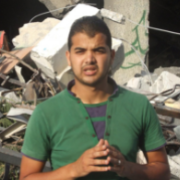
– Abdallah Aljamal is a Gaza-based journalist. He is a correspondent for The Palestine Chronicle in the Gaza Strip.
50 Palestinians were killed and nearly 200 arrested by Israeli forces at the Al-Shifa Hospital in Gaza. (Photo: via WAFA)
By Palestine Chronicle Staff
“Hundreds of Israeli occupation soldiers armed to the teeth, with police dogs, dozens of tanks, drones, and helicopters participated in the raid on the Al-Shifa Medical Complex”.
Israeli forces killed 50 Palestinians at the Al-Shifa Medical Complex in Gaza City and detained at least 180 more, the Israeli army said in a statement on Tuesday.
“Battles are taking place between Israeli forces” and Palestinian fighters, the statement added.
The Gaza government media office slammed the Israeli ‘bloody massacre’, calling on the United Nations and the international community to urgently intervene.
‘Clear War Crime’
“The Israeli occupation army admitted to committing a bloody massacre by executing more than 50 Palestinian civilians and arresting about 200 others in the Al-Shifa Medical Complex and its vicinity in Gaza City,” the Gaza office said in a statement.
According to the office, a number of children were also executed.
“Hundreds of Israeli occupation soldiers armed to the teeth, with police dogs, dozens of tanks, drones, and helicopters participated in the raid on the Al-Shifa Medical Complex,” the statement said.
By Palestine Chronicle Staff
“Hundreds of Israeli occupation soldiers armed to the teeth, with police dogs, dozens of tanks, drones, and helicopters participated in the raid on the Al-Shifa Medical Complex”.
Israeli forces killed 50 Palestinians at the Al-Shifa Medical Complex in Gaza City and detained at least 180 more, the Israeli army said in a statement on Tuesday.
“Battles are taking place between Israeli forces” and Palestinian fighters, the statement added.
The Gaza government media office slammed the Israeli ‘bloody massacre’, calling on the United Nations and the international community to urgently intervene.
‘Clear War Crime’
“The Israeli occupation army admitted to committing a bloody massacre by executing more than 50 Palestinian civilians and arresting about 200 others in the Al-Shifa Medical Complex and its vicinity in Gaza City,” the Gaza office said in a statement.
According to the office, a number of children were also executed.
“Hundreds of Israeli occupation soldiers armed to the teeth, with police dogs, dozens of tanks, drones, and helicopters participated in the raid on the Al-Shifa Medical Complex,” the statement said.
Israeli Raid
On Monday morning, Israeli occupation forces stormed the largest hospital in the Strip, took control of the complex and detained scores of people.
Al-Jazeera correspondent Anas al-Sharif reported that Israeli occupation forces detained displaced men and youth after storming a number of schools in the vicinity of the Al-Shifa Complex.
Israeli troops reportedly ordered all women to head to Deir Al-Balah via Al-Rashid Street.
Israeli occupation forces also besieged two schools in the vicinity of the medical complex.
Footage circulating online shows the presence of Israeli military vehicles and bulldozers inside the Shifa Medical Complex with bulldozing operations inside the square.
The siege is now continuing for the second day in a row, and Palestinian civilians are trapped inside the building, with no access to food or water.
Gaza authorities called for “an immediate and urgent intervention by all United Nations and international organizations,” the statement said, adding, “we call on all countries of the free world to stop the genocide war and halt the aggression on the Gaza Strip, which specifically targets civilians, children, and women.”
Gaza Genocide
Currently on trial before the International Court of Justice for genocide against Palestinians, Israel has been waging a devastating war on Gaza since October 7.
According to Gaza’s Ministry of Health, 31,819 Palestinians have been killed, and 73,934 wounded in Israel’s ongoing genocide in Gaza starting on October 7.
Moreover, at least 7,000 people are unaccounted for, presumed dead under the rubble of their homes throughout the Strip.
Palestinian and international organizations say that the majority of those killed and wounded are women and children.
The Israeli aggression has also resulted in the forceful displacement of nearly two million people from all over the Gaza Strip, with the vast majority of the displaced forced into the densely crowded southern city of Rafah near the border with Egypt – in what has become Palestine’s largest mass exodus since the 1948 Nakba.
Israel says that 1,200 soldiers and civilians were killed during the Al-Aqsa Flood Operation on October 7. Israeli media published reports suggesting that many Israelis were killed on that day by ‘friendly fire.’
(The Palestine Chronicle)
‘Please Help Us’ – Palestine Chronicle Speaks to Two Palestinians Inside Besieged Al-Shifa Hospital
Israeli tanks surrounding the Al-Shifa Medical Complex in Gaza City.
(Photo: via WAFA)

By Abdallah Aljamal – Gaza
The Palestine Chronicle spoke with two eyewitnesses, who are still trapped inside the hospital when Israeli forces raided the building.
Many Palestinians were killed and wounded as a result of the attack carried out on Monday morning by Israeli occupation forces on the Al-Shifa Medical Complex in Gaza City.
Daniel Hagari, the spokesman of the Israeli army, said early on Monday that Israeli occupation forces were “conducting a high-precision operation in limited areas of Shifa hospital based on (…) intelligence information indicating the use of the hospital by senior Hamas terrorists to command attacks”.
Hours later, the Israeli army stormed the largest hospital in the Strip, took control of the complex and detained at least 80 people, including journalists.
Israeli occupation forces also besieged two schools in the vicinity of the medical complex.
The Palestine Chronicle spoke with two eyewitnesses, who are still trapped inside the hospital when Israeli forces raided the building.
For security reasons, we will use their initials instead of their full name, in order to keep their identity private.

By Abdallah Aljamal – Gaza
The Palestine Chronicle spoke with two eyewitnesses, who are still trapped inside the hospital when Israeli forces raided the building.
Many Palestinians were killed and wounded as a result of the attack carried out on Monday morning by Israeli occupation forces on the Al-Shifa Medical Complex in Gaza City.
Daniel Hagari, the spokesman of the Israeli army, said early on Monday that Israeli occupation forces were “conducting a high-precision operation in limited areas of Shifa hospital based on (…) intelligence information indicating the use of the hospital by senior Hamas terrorists to command attacks”.
Hours later, the Israeli army stormed the largest hospital in the Strip, took control of the complex and detained at least 80 people, including journalists.
Israeli occupation forces also besieged two schools in the vicinity of the medical complex.
The Palestine Chronicle spoke with two eyewitnesses, who are still trapped inside the hospital when Israeli forces raided the building.
For security reasons, we will use their initials instead of their full name, in order to keep their identity private.
Just before Suhoor
“Just before our suhoor meal (just before dawn – PC), we were surprised by the incursion of Israeli special forces into the Al-Shifa Medical Complex in Gaza City, amid heavy gunfire,” H.S., one of the Palestinians who were besieged inside the hospital, told The Palestine Chronicle.
“The quadcopter drones surrounded the compound, firing at anyone attempting to leave,” he added.
H.S., who preferred not to disclose his full name for fear of reprisal from the occupation forces, continued: “We were taken aback by the fact that Israel decided to storm Al-Shifa for the second time.”
The medical compound is currently hosting thousands of displaced Palestinians, including children, women, elderly, in addition to hundreds of patients.
“None of us could leave the place, so we all sought refuge inside the building. The place was extremely crowded, we heard children’s cries echoing, relentlessly. Fear was paralyzing, and the sounds of shelling and gunfire continued for hours.”
As the news spread regarding the storming of Al-Shifa, people in Gaza started worrying about the fate of their relatives, trapped inside the hospital.
“Our families called repeatedly to check on us, but we were in an extremely difficult situation,” H.S. explained.
“The chances of being killed, injured or arrested were very high”.
“They (the Israeli army – PC) demolished the tents of Palestinian journalists and they detained a large number of them. All those arrested were stripped of their clothes, handcuffed, blindfolded, and placed in a room inside the complex for several hours,” the eyewitness said.
“My house was bombed earlier. That’s why I decided to evacuate with my family to the Al-Shifa Complex because we thought that the Israeli army had concluded its military operations there, but this morning, we were surprised by its return”.
My Injured Daughter
M.S. is another eyewitness to the Israeli army raid at the Al-Shifa Medical Complex. On Monday morning, he went to the hospital to get some medication for his injured daughter.
He explained to us that the only reason why he could not reveal his full name is that he is the only provider in his family at the moment.
“I am the father of three martyrs, while both my daughter and I were injured by an Israeli bombing that targeted our home, in a residential area in Gaza City,” M.S. told us.
“My daughter’s foot was amputated, and she suffers from severe malnutrition due to the lack of proper medication and treatment,” he said.
“On Sunday night, I went to Al-Shifa Medical Complex to get some medications and medical supplies for my wounded daughter. However, following the intensification of the shelling around the compound, I couldn’t return home, so I was forced to stay overnight.”
M.S. told us that, like all other displaced Palestinians, he was just looking for some medicine, some food for suhoor and some water to drink before the Fajr prayer.
“But the occupation forces surprised us,” he said. “I went there to get medical supplies for my daughter, but now I am trapped with thousands of people inside the complex, surrounded by death, Israeli shelling, and destruction from all sides.”
M.S. told us that there is no food or water, and that Israeli bulldozers keep destroying everything in the vicinity of the hospital’s main building.
“We only wish for their withdrawal so that we can leave the complex. There is no safe place in Gaza. We call for urgent intervention to rescue the displaced, the wounded, and the medical staff trapped inside the complex.”
(The Palestine Chronicle)

– Abdallah Aljamal is a Gaza-based journalist. He is a correspondent for The Palestine Chronicle in the Gaza Strip.
Israel turns Gaza's Al-Shifa Hospital into battleground
The raid on the Al-Shifa Hospital comes as Israeli Prime Minister Benjamin Netanyahu doubled down on his intentions to invade Rafah in Gaza's south
The New Arab Staff & Agencies
18 March, 2024
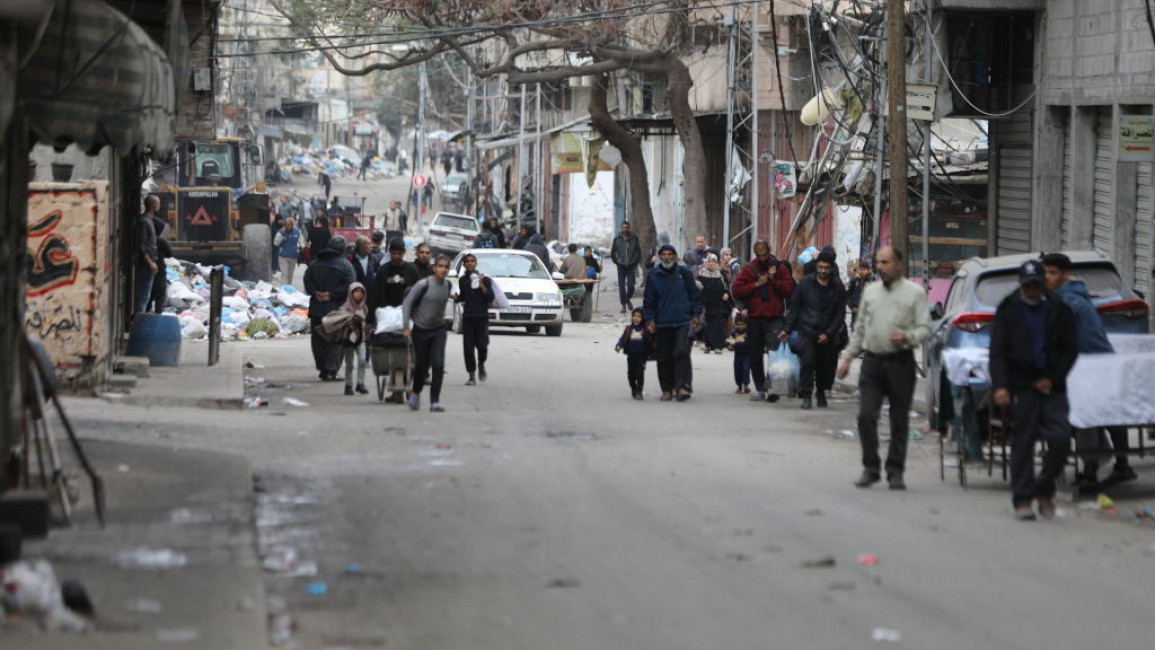
Thousands of civilians have been forced to evacuate Al-Shifa and its surrounding area by the Israeli military [Photo by Dawoud Abo Alkas/Anadolu via Getty Images]
The Israeli army launched a renewed attack on Gaza's largest hospital, Al-Shifa, with witnesses reporting air strikes on the devastated neighbourhood where it is located.
Witnesses in Gaza City told AFP they saw tanks surround the hospital site.
Tens of thousands of Palestinians displaced by the war have sought shelter in the complex, according to the health ministry in Gaza.
The Israeli army had also carried out a November operation in Al-Shifa, sparking an international outcry.
The government media office in Gaza condemned the operation, saying that "the storming of the Al-Shifa medical complex with tanks, drones, and weapons, and shooting inside it, is a war crime".
The health ministry in the besieged territory said it had received calls from people near the hospital site who claimed there were dozens of casualties.
"No one could transport them to the hospital due to the intensity of gunfire and artillery shelling," the ministry said.
The Israeli army has carried out multiple operations in and around medical facilities across the Gaza Strip since the start of the war.
Israel claims that Hamas is running military operations from hospitals and other medical centres, but Hamas denies this.
Breaking bread in Gaza has become a matter of life and death
Israel vowed to destroy Hamas after the Palestinian group launched a surprise attack on Israel on October 7 2023, killing an estimated 1,160 Israelis, most of them civilians.
Israel has since then launched a brutal and indiscriminate attack on the Gaza Strip, targeting schools, hospitals, and residential areas and killing at least 31,645 people, most of them women and children. A further 73,792 have also been injured.
Palestinian militants seized about 250 Israeli and foreign captives during the October 7 attack, but dozens were released during a week-long truce in November.
Israel believes about 130 remain in Gaza, including 33 - eight soldiers and 25 civilians - who are presumed dead.
Israel said that there was "no obligation for the patients and medical staff to evacuate" during its attack on the Al-Shifa Hospital and that it would avoid targeting hospital facilities and equipment.
However, Israel has since instructed those residing in and around the hospital south to the Israeli designated "humanitarian zone".
Following its November 15 operation on Al-Shifa, the Israeli military said it had found weapons and other military equipment hidden in the site - claims Hamas has denied.
It also claimed it had found a 55-metre tunnel in the basement and shared footage that it claimed proved hostages had been held there, which Hamas also denied.
According to the UN, 155 health facilities in the Gaza Strip have been damaged since the war began.
'Where should they go?'
The health ministry said early Monday that dozens of people had been killed across the Gaza Strip overnight.
Over the weekend, 12 members of the same family were killed when their house was hit in Deir al-Balah in central Gaza.
Palestinian girl Leen Thabit, retrieving a white dress from under the rubble of their flattened house, cried as she told AFP her cousin was killed in the strike.
"She's dead. Only her dress is left," Thabit said.
For several weeks, the focus of Israel's attack had been on southern Gaza, where around 1.5 million people who have fled the remainder of the devastated territory have sought refuge since the start of the war.
Allies of Israel, including the United States, have warned Prime Minister Benjamin Netanyahu's government against launching a full-scale operation in Rafah near the Egyptian border.
Israel's no-state solution and the endurance of Palestine
Rafah is the only urban centre in Gaza where Israeli ground troops have yet to enter.
Visiting German Chancellor Olaf Scholz told reporters that if such an offensive resulted in "a large number of casualties" it "would make any peaceful development in the region very difficult".
Israel has insisted, however, that its war aim of eliminating Hamas cannot be achieved without an attack on Rafah.
On Sunday, Netanyahu vowed civilians crammed into the south of the strip would be able to leave before troops enter in pursuit of Hamas militants.
The office of Netanyahu had on Friday said he approved the military's plan for an attack on Rafah as well as "the evacuation of the population".
"Our goal in eliminating the remaining terrorist battalions in Rafah goes hand-in-hand with enabling the civilian population to leave Rafah," Netanyahu said at a press appearance alongside Scholz.
"It's not something that we will do while keeping the population locked in place."
As others have done, Scholz raised the question:
"Where should they go?"
'Out of harm's way'
The United States, which provides Israel with billions of dollars in military assistance, has said it wants a "clear and implementable plan" to ensure civilians are "out of harm's way".
Gaza is facing the threat of famine, according to the UN, and many residents of the territory have faced displacement multiple times in recent months.
There has been no indication yet of where those crammed into Rafah could go, and any suggestion of Palestinian dispersal outside the Palestinian Territories is highly contentious in the Arab world, raising fears of a second Nakba.
A Hamas proposal for a truce calls for an Israeli withdrawal from "all cities and populated areas" in Gaza and for more humanitarian aid, according to an official from the group.
International envoys were planning to meet in Qatar soon to revive stalled talks for a ceasefire and hostage release deal.
Israel plans to attend the talks, and a cabinet meeting meant to decide the delegation's mandate took place on Sunday night, Netanyahu's office said.
As a result of the meetings Israel's chief of the Mossad intelligence agency is heading to Qatar to secure a six-week truce and the return of 40 Israeli captives according to Israeli officials speaking to Reuters, although it is unknown how many Palestinian's will be released as part of a deal.
Israel's latest attack on al-Shifa Hospital and the successful delivery of food aid to northern Gaza are connected. Here's how.
AID ARRIVES AT UNRWA FACILITY IN JABALIA, NORTHERN GAZA, MARCH 17, 2024. (PHOTO: ASHRAF AMRA/APA IMAGES)
In the past two days, a number of things happened that seemingly had nothing to do with each other. At 2:00 a.m. on Monday, the Israeli army stormed al-Shifa hospital, entering with tanks and heavy gunfire and killing and injuring dozens. It was the fourth invasion of al-Shifa since October, resulting in the arrest of over 80 people.
The day before, 13 aid trucks arrived in northern Gaza for the first time in four months without being turned back by the Israeli army or resulting in the massacre of starving Palestinian aid-seekers. People flocking to the UNRWA warehouse in Jabalia refugee camp to receive the aid stood in uncharacteristically orderly lines and patiently waited for the handouts of flour, rice, and other foodstuffs. Many could be seen cheering once the aid arrived, a scene captured by Al Jazeera’s coverage.
But what few people know is that this successful delivery of sorely needed food aid to northern Gaza is what led the Israeli army to launch its deadly raid on al-Shifa Hospital the next day.
The connection between these two events can only be explained by understanding who Israel was targeting in the raid — the now-martyred Faiq Mabhouh.
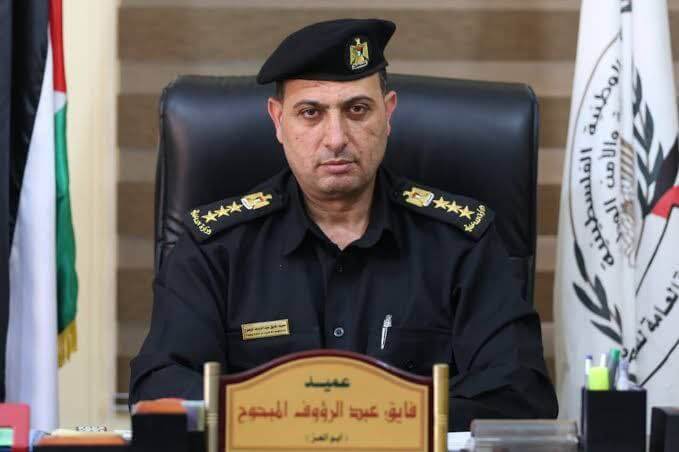
FAIQ MABHOUH (PHOTO: SOCIAL MEDIA)
Mabhouh was the Director of Operations of the Gaza police force, a part of the Gaza government’s civilian administration. Unlike Hamas’s military wing, the Qassam Brigades, Mabhouh did not operate clandestinely at the start of the war, because he didn’t have to — he was in charge of civil law enforcement. Hamas released a statement after his death confirming that he “engaged in purely civil and humanitarian activity.”
Yet to hear Israeli military spokespersons and the Israeli media, Israel had launched a “precise operation” on al-Shifa to target a “top Hamas operative,” or a “senior Hamas commander,” who the army alleged was planning attacks on Israel.
The attack on al-Shifa was an assassination operation aimed at breaking down civil order in northern Gaza to facilitate Israel’s genocidal project.
Making such brazen claims without evidence to justify attacking hospitals and shelters has been a hallmark of the Israeli army’s conduct throughout its genocidal assault. But the true significance of the attack lies not in its desire to empty northern Gaza’s largest civilian refuge, which houses 30,000 people, but in foiling Faiq Mabhouh’s pivotal role in coordinating the delivery of humanitarian aid to starving civilians in Gaza while restoring a semblance of social order to the north.
In other words, the attack on al-Shifa was an assassination operation aimed at breaking down civil order in northern Gaza. It aimed to facilitate Israel’s genocidal project and pave the way for total control over the area without resistance.
The unfolding events of the past few days expose Israel’s intentions of engineering famine and contributing to social breakdown. It reminds us that this is not only a war against Gaza’s resistance but also against its people.
Delivering aid while avoiding another ‘flour massacre’
On March 17, images of pamphlets circulated on social media bearing the signature of the “Palestinian Security Forces” addressed to all civilians in northern Gaza. In order to “ensure the secure arrival of aid” in the north, the notice barred all people from gathering at the Kuwaiti roundabout and Salah al-Din Street, the main entry points through which humanitarian aid reaches the north. In most previous attempts, throngs of starving people gathered at those locations and rushed aid trucks as they arrived.
Israeli forces fired on the crowds many times, killing hundreds of people, most infamously during the “Flour Massacre” on March 3. On occasions where Israel did not mow down the desperate crowds, it stopped aid trucks and turned most of them back, citing spurious “dual use” claims.
Yet what is most remarkable about the circulation of this notice is that the starving people of northern Gaza complied. The aid convoy arrived in Jabalia refugee camp at a UNRWA facility shortly after midnight on March 17, unmolested and to much popular fanfare.
Mabhouh was the Director of Operations of the Gaza police force, a part of the Gaza government’s civilian administration. Unlike Hamas’s military wing, the Qassam Brigades, Mabhouh did not operate clandestinely at the start of the war, because he didn’t have to — he was in charge of civil law enforcement. Hamas released a statement after his death confirming that he “engaged in purely civil and humanitarian activity.”
Yet to hear Israeli military spokespersons and the Israeli media, Israel had launched a “precise operation” on al-Shifa to target a “top Hamas operative,” or a “senior Hamas commander,” who the army alleged was planning attacks on Israel.
The attack on al-Shifa was an assassination operation aimed at breaking down civil order in northern Gaza to facilitate Israel’s genocidal project.
Making such brazen claims without evidence to justify attacking hospitals and shelters has been a hallmark of the Israeli army’s conduct throughout its genocidal assault. But the true significance of the attack lies not in its desire to empty northern Gaza’s largest civilian refuge, which houses 30,000 people, but in foiling Faiq Mabhouh’s pivotal role in coordinating the delivery of humanitarian aid to starving civilians in Gaza while restoring a semblance of social order to the north.
In other words, the attack on al-Shifa was an assassination operation aimed at breaking down civil order in northern Gaza. It aimed to facilitate Israel’s genocidal project and pave the way for total control over the area without resistance.
The unfolding events of the past few days expose Israel’s intentions of engineering famine and contributing to social breakdown. It reminds us that this is not only a war against Gaza’s resistance but also against its people.
Delivering aid while avoiding another ‘flour massacre’
On March 17, images of pamphlets circulated on social media bearing the signature of the “Palestinian Security Forces” addressed to all civilians in northern Gaza. In order to “ensure the secure arrival of aid” in the north, the notice barred all people from gathering at the Kuwaiti roundabout and Salah al-Din Street, the main entry points through which humanitarian aid reaches the north. In most previous attempts, throngs of starving people gathered at those locations and rushed aid trucks as they arrived.
Israeli forces fired on the crowds many times, killing hundreds of people, most infamously during the “Flour Massacre” on March 3. On occasions where Israel did not mow down the desperate crowds, it stopped aid trucks and turned most of them back, citing spurious “dual use” claims.
Yet what is most remarkable about the circulation of this notice is that the starving people of northern Gaza complied. The aid convoy arrived in Jabalia refugee camp at a UNRWA facility shortly after midnight on March 17, unmolested and to much popular fanfare.

The convoy was accompanied by an escort of masked gunmen whose identities were unknown. Much speculation as to who they were abounded, with Al Jazeera correspondent Ismail al-Ghoul commenting that the aid convoy was coordinated by Gaza’s clans. Later on that same day, as the aid was being distributed, Al Jazeera reporter Anas al-Sharif said that the convoy was organized by “local committees and monitoring committees comprised of clans, notables, and elders, who oversaw the arrival of the aid.”
Yet that same broadcast showed images of those processing the handouts, who used laptops to register aid recipients with their ID cards and entered them into a registry. These were the tell-tale signs of the bureaucracy of Gaza’s civil government.
Yet that same broadcast showed images of those processing the handouts, who used laptops to register aid recipients with their ID cards and entered them into a registry. These were the tell-tale signs of the bureaucracy of Gaza’s civil government.

AL JAZEERA BROADCAST OF DISTRIBUTION OF FOOD AID.
(PHOTO: SCREENSHOT FROM AL JAZEERA YOUTUBE CHANNEL)
Al Jazeera’s footage also depicted long, orderly lines of people receiving aid, in sharp contrast with the chaotic and bloody scenes that had predominated in previous incidents at the Kuwait roundabout and Salah al-Din Street. The scene was clear in its implication: attempts were being made to restore civil order in northern Gaza and to improve the lot of the suffering population.
Not 24 hours later, in the predawn hours of March 18, Israel invaded al-Shifa. The news emerged that the army had assassinated Faiq Mabhouh, and that an Israeli soldier had been killed after Mabhouh reportedly refused to surrender. Suddenly all news sources were saying the same thing: Mabhouh had been behind the effort to coordinate the arrival of the aid.
Al Jazeera’s footage also depicted long, orderly lines of people receiving aid, in sharp contrast with the chaotic and bloody scenes that had predominated in previous incidents at the Kuwait roundabout and Salah al-Din Street. The scene was clear in its implication: attempts were being made to restore civil order in northern Gaza and to improve the lot of the suffering population.
Not 24 hours later, in the predawn hours of March 18, Israel invaded al-Shifa. The news emerged that the army had assassinated Faiq Mabhouh, and that an Israeli soldier had been killed after Mabhouh reportedly refused to surrender. Suddenly all news sources were saying the same thing: Mabhouh had been behind the effort to coordinate the arrival of the aid.
Mabhouh’s role
The information available on Mabhouh’s duties remains scant, often blending fact with speculation regarding his activities and the reason for his assassination. Most media sources agree that Mabhouh organized the delivery of the aid convoy, which he did in coordination with Gaza clans, UNRWA, and international organizations.
Crucially, that coordination entailed meeting with officials from those groups. One of the widespread pieces of speculation holds that it was at those meetings that Mabhouh’s location was exposed and supposedly leaked to Israel’s intelligence, likely through one of those international organizations. Haaretz speculates that this intelligence leak “may explain Israel’s urgency to launch an immediate operation at the hospital.”
Being the head of a civilian police force, Mabhouh operated publicly earlier on in the war, but as Israel continued to target members of the local police, the need for secrecy became more apparent. According to Axios, the Biden administration asked Israel back in February to “stop targeting members of the Hamas-run civilian police force who escort aid trucks in Gaza, warning that a ‘total breakdown of law and order’ is significantly exacerbating the humanitarian crisis.”
Israel never stopped targeting them and indeed went above and beyond in massacring hundreds of civilians seeking food. This context explains why the police force apparently switched to operating clandestinely and why the gunmen accompanying the convoy were masked. It also explains why the public narrative around the distribution of the aid was that it was organized by the clans.
But mention of the clans is not incidental here. One of the most important aspects of Israel’s supposed “day after” scenario for Gaza is that day-to-day activities would be managed by local families and tribes. Gaza’s traditional clans used to hold greater sway in the coastal enclave prior to Hamas’s ascendancy to power in 2007, some of them acting as lawless gangs that engaged in criminal activity. Hamas severely curtailed their role during its period of rule over the Strip, but during the latest genocidal war, many of these families took advantage of the chaos to commandeer aid convoys and hoard food aid or sell it on the black market.
Israel has not only welcomed the development but actively encouraged the state of lawlessness. Its continued targeting of Gaza police escorts only reinforced the phenomenon. At around the same time, Israeli officials began to float the idea of postwar tribal rule in Gaza.
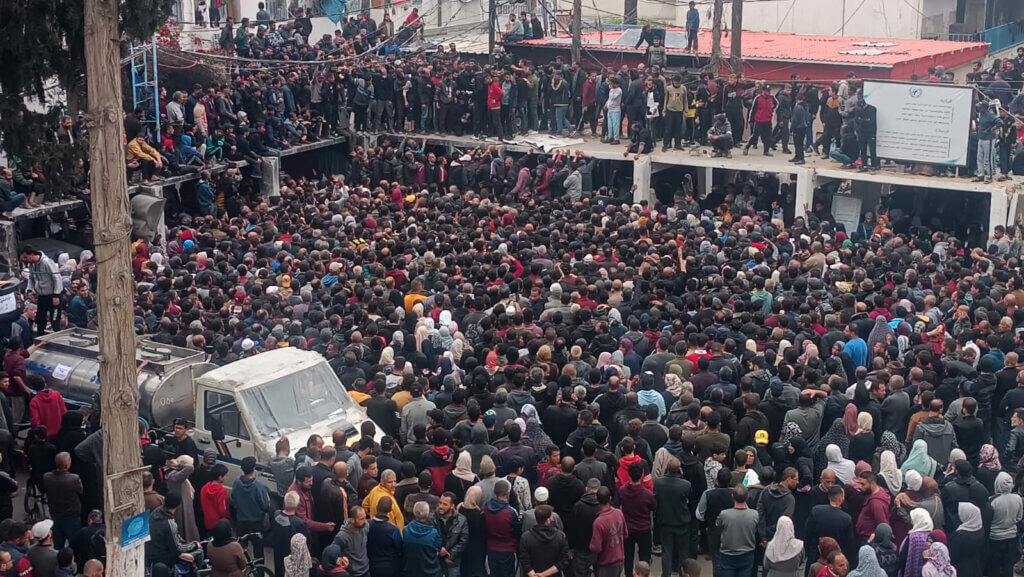
PALESTINIANS GATHER IN FRONT OF UN AGENCY FOR PALESTINIAN REFUGEES (UNRWA) BUILDING TO RECEIVE FLOUR IN JABALIA, GAZA CITY, MARCH 17, 2024.
(PHOTO: ASHRAF AMRA/APA IMAGES)
This relates to the second part of the speculation surrounding Mabhouh’s assassination — that he was involved in cracking down on clans that seized food aid, likely to be the same clans who would be contenders in Israel’s vision of postwar rule in Gaza.
One unsubstantiated rumor was widely circulated on social media in Arabic and picked up by the Israeli media: Hamas had supposedly executed the unnamed head of the influential Doghmosh clan in Gaza for allegedly stealing humanitarian aid and being suspected of collaborating with Israel. The Doghmosh clan put out a statement strongly denying the claim, asserting that the clan chief had been martyred during an Israeli airstrike on November 16, 2023. An investigation conducted by Al Jazeera revealed that the name of the family’s head (the mukhtar) was on the list of the dead from that airstrike.
Regardless of the veracity of the speculation, what has become clear is that Israel’s genocidal war has taken on a new dimension — it is encouraging societal collapse in Gaza. Its engineering of famine and the enablement of lawlessness is simply a continuation of its military campaign through other means. And when members of the civilian government attempt to ameliorate the famine or try to work to restore social order, Israel launches a war against them, too.
Thanks to Jehad Abusalim for contributing crucial insights to this report.
This relates to the second part of the speculation surrounding Mabhouh’s assassination — that he was involved in cracking down on clans that seized food aid, likely to be the same clans who would be contenders in Israel’s vision of postwar rule in Gaza.
One unsubstantiated rumor was widely circulated on social media in Arabic and picked up by the Israeli media: Hamas had supposedly executed the unnamed head of the influential Doghmosh clan in Gaza for allegedly stealing humanitarian aid and being suspected of collaborating with Israel. The Doghmosh clan put out a statement strongly denying the claim, asserting that the clan chief had been martyred during an Israeli airstrike on November 16, 2023. An investigation conducted by Al Jazeera revealed that the name of the family’s head (the mukhtar) was on the list of the dead from that airstrike.
Regardless of the veracity of the speculation, what has become clear is that Israel’s genocidal war has taken on a new dimension — it is encouraging societal collapse in Gaza. Its engineering of famine and the enablement of lawlessness is simply a continuation of its military campaign through other means. And when members of the civilian government attempt to ameliorate the famine or try to work to restore social order, Israel launches a war against them, too.
Thanks to Jehad Abusalim for contributing crucial insights to this report.
